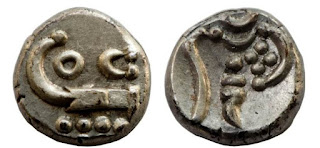The Fanams (also spelled Fanoms) were known to be amongst the smallest coins in the world. The words Fanam and Panam literally mean money in the native language of Malayalam. They were part of the traditional coinage of Kerala. The Panam coins rose in popularity some time in the 13th century AD and remained one of the most popular currencies in circulation in the subsequent centuries
Mysore, Haidar Ali, 1763-1782 AD, Fanam
Other versions of the Fanams are known to be minted in Kerala by the kingdoms of Cochin, Kozhikode, Mysore, Dutch India and other kingdoms of South India. The adjoining states in the present day Tamil Nadu, Karnataka and Sri Lanka are also known to have their own versions of the Fanams.
By the 18th century, the reduction in precious metal content had rendered the Travancore Fanam coins so small that they had become difficult to count. They were counted by pouring them into a counting board (called palakas) and shaking them into the holes on the surface of the board.
Map of Travancore, 1871
The modern version of the Travancore Fanams were introduced into circulation around 1800, with a value equal to 4 Chukrama. Theses were minted in Trivandrum, (now called Thiruvananthapuram) with the aid of stamping presses obtained from Madras Presidency. Later issues were minted using presses procured from England . While the older versions of the Fanams were based on gold or silver, these newer coins were primarily based on silver. They were issued until 1946-47, remaining in circulation until 1949 before being replaced by the Indian Rupee and Anna system.
Map of Malabar Coast, 1733 AD. Travancore was a small territory between Kollam and Kanyakumari
Older issues of the Panam coins are inscribed with various symbols representing religious deities or nature, but issues from the 1860's onwards often had the names or insignia of the reigning monarch in English. The Fanam coins, were also written in English. The year, when inscribed on the Fanams was based on the Malayalam calendar (and corresponding Malayalam Era- ME) which begins circa 825 AD. Therefore the year of issue of the coin can be found by adding 825 to it.
Travancore in the Madras Presidency in 1909
Madras Presidency used the Fanam currency until 1815. It circulated alongside the Indian Rupee, also issued by the Presidency. The Fanam was subdivided into 80 copper cash, with the gold pagoda worth 42 Fanams. The Rupee was wort 12 Fanams. After 1815, only coins of the rupee currency were issued.
Map of Cochin in 1635 AD, Livro das Plantas de Todas as Fortalezas, a catalogue of Portuguese forts in India
Travancore Fanam was worth 1/7 of a Rupee, and equal to 4 Chuckrams, whilst in Danish India the fanon was issued, worth 1/8 rupee, and in French India the fanon was wort 1/8 rupee.
The capture of Cochin from the Portuguese by Rijckloff van Goens in 1663 AD.























Another gem from your treasure trove
ReplyDelete